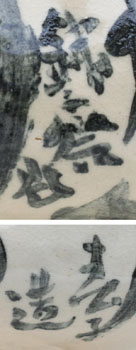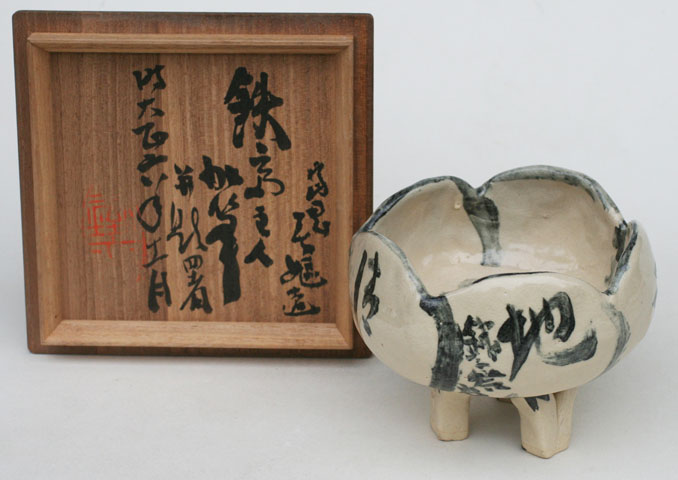chadô
Kôro, three legged plumblossom shaped bowl for scent - Adding heaven and earth with clear fragrance.Signed: Tessai .. & Haruko zô
Seals:
Technique: Fine cracled glazed with a black tetsu-e, iron oxyde underglaze decoration Ø 13 x 9,8
Date: 1917
Box: Signed by Tessai
Condition: fine
滿天地清香 -Tenchi ni seika o mitsu: To add heaven and earth with clear fragrance.
Box inscription outside: 梅花式香濾 umehanaa shiki Kôro, Kôro for the plum blossom ceremony
inside: 富岡春嫗造 鐵斎之人加筆並題署 時大正六年二月「印」鉄斎
Tomioka Haruôna zô Tessai jin kahitsu heidai sho ji Taishô rokunen jûichi gatsu [seal:] Tessai
The old ladyTomioka Haru[ko] fired, Tessai added his brush, Taishô 6 (1917)
Tessai was born in Kyoto into a family selling robes and accessories for the Buddhist clergy. As a result of a childhood illness he became partly deaf. It was therefore considered improbable that he would ever become a successful shopkeeper. Instead he went to study the Japanese classics in order to become a Shinto priest. He also did Chinese studies, specializing in the teachings of the neo-confucianist Wang Yang-Ming. Later he would study Buddhism, literature and Shingaku, a semi-religious system for self-cultivation.
As a youth Tessai met Ōtagaki Rengetsu (1791-1875) and became her special protégé. She taught him waka and encouraged his artistic inclinations. Tessai was mainly self-taught, indepently studying Nanga painting and learning from friends. He was, however, strongly influenced by Shinten’ô.
In the final years of the Tokugawa era Tessai was involved in the pro-imperialist movement. For fear of being arrested he left Kyoto in 1861 and travelled to Nagasaki. It was the first of many trips; Tessai became and avid traveller. In 1882 he settled in Kyoto where he spent the rest of his life. Although he worked as a priest at several Shinto shrines, he saw painting as his chief occupation. Between 1894 and 1904 he was a teacher at the Kyoto Prefectural Art School and he was a regular contributor to exhibitions of the Nanga Society. In 1917 he was appointed Artist to the Imperial Household and towards the end of his life he received an honorary court-rank. Tessai is often seen as the last great exponent of the Nanga school. (AB)
Reference:
Kanazawa
Kato 1998
Roberts p. 181
Araki pp. 2754-2755
Aburai pp. 266-267
Morioka & Berry ‘99 pp. 116-121 (# 20-21)
Morioka & Berry ‘08 p. 305-06 (# 11, 46)
Sasaki Haruko was born into a Samurai family in Iyo (today Ehime Prefecture) the third daughter of a Sasaki Tei. In 1872 she married Tomioka Tessai.
Price: SOLD

